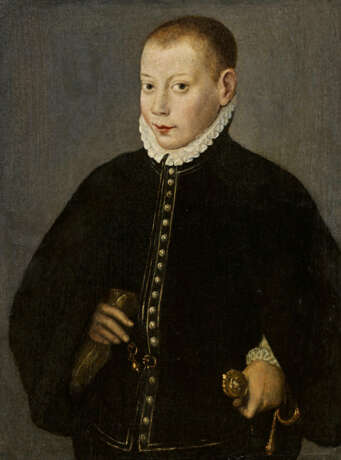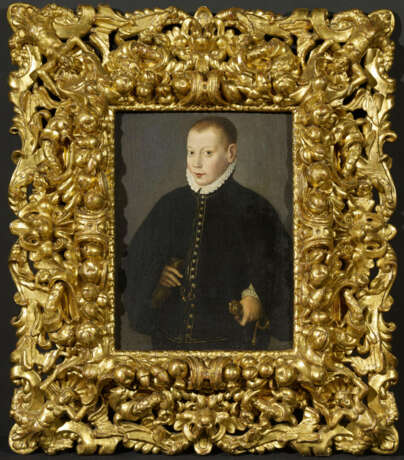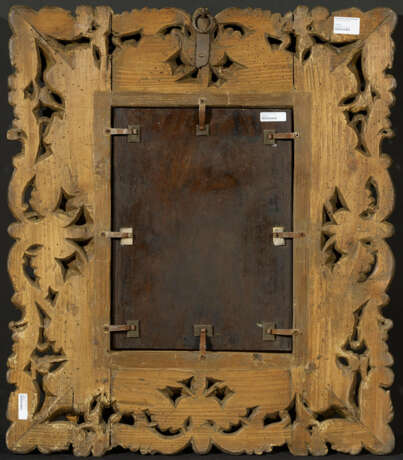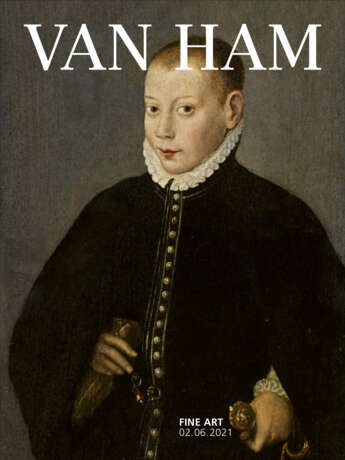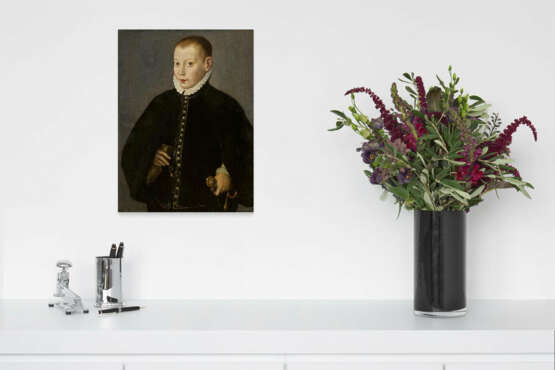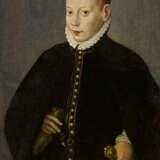ID 548763
Lot 926 | Portrait of a Child
Valeur estimée
€ 35 000 – 45 000
ca. 1535 Cremona - 1625 Palermo
Title: Portrait of a Child.
Technique: Oil on wood.
Measurement: 37 x 28cm.
Frame/Pedestal: Framed.
Verso:
Old inscriptions on the panel.
Certificate:
M. Tanzi, Cremona, 23.02.2021, is available.
Provenance:
Private ownership, Switzerland.
The painting shows a boy in half-portrait wearing an elegant black velvet dress trimmed in gold with numerous buttons and a thin belt at the waist, while on his shoulders he wears a coat from which the collar and cuffs of white lace peek out. In the lower part of the picture, one can glimpse a pair of wide, gold-striped trousers. In his right hand the child holds a pair of gloves, while in his left hand he holds the hilt of a sword, possibly indicating that his family belonged to the military nobility. The face, framed by thinning reddish hair, is lit by a proud and intense gaze; a hint of a smile seems to express the knowledge of his rank despite his young age. The forms are shaped by a soft, delicate chiaroscuro and the figure stands out without complacency, thanks to the skilful play of colour contrasts, which are not overemphasised, on a beautiful neutral grey-brown background varied by shadows.
The dazzling portrait shows the typical features of courtly portrait painting between the seventh and eighth decades of the 16th century. In particular, the painterly peculiarities and some stylistic details allow us to attribute the work to the Cremonese painter Sofonisba Anguissola, who had long left her training in her native city behind at the time of the present painting's creation and was already beyond the important period at Philip II's court in Madrid, where she learned the dictates of court portraiture. It is in fact a work that can be placed in the first sojourn in Sicily, where Sofonisba arrived in 1573 with full honours and - thanks to the monarch's generosity - a rich dowry, to marry Fabrizio Moncada, governor of Paternò. There is not much information about this chapter of Sofonisba's activity - which was quite short, considering that she became a widow in April 1578 - but the research of recent years has made it possible to refer with certainty to the large panel with the Madonna dell'Itria, donated to the Franciscan monastery of Paternò on 25 June 1579 and now in the church of Santissima Annunciata. The morphology of the Virgin's face shows particular similarities with the features of our child, such as the typical shell shape of the eyes and the representation of the nose and mouth. These features are found in a wide range of Anguissola's figures: from the Nun of Southampton from 1551, to Massimiliano Stampa, in the Cook Collection in Richmond, to the Three Boys at Corsham Court, where the hair of the one standing in the middle is painted with the same light and fine brushstroke, to Alessandro Farnese from the National Gallery of Ireland in Dublin, who shows the same proud posture as our boy. It is then the portraits of the Genoese years that show further affinities with the present portrait, such as the Infanta Caterina Micaela Duchess of Savoy now in the Prado, the other of the same Infanta, with fur collar and veiled head, in the Stirling Collection of Pollok House, in Glasgow. Our painting belongs to the typology of semi-portraits of this period between Madrid and Genoa, in which the physiognomic characterisation of the sitter is not accentuated on the basis of the naturalistic dictates learned in youth at Cremona, nor does it revel in the embalming of the portrait, as at the Spanish court. Rather, the painting gives way to a more minute and detailed taste for decorative detail, while the setting is the usual one, simplified as much as possible as in the portraits of the Madrid period.
Anguissola was an accomplished portrait painter who achieved international fame very early on: in Cremona she followed the teachings of her masters Bernardino Campi and Bernardino Gatti and succeeded in creating works that bordered on the delightful, such as the family portrait in the Nivaagaards Malerisamling, the painting with the chess game in Posen and portraits, portraits that explore the psychology of the sitter and dare to go beyond the surface of the skin, like that of the Canon of Brescia. At the court of Philip II, on the other hand, we get lost in a whirlpool of painters portraying the same figures and copying the same model over and over again: The royal family was depicted by Anthonis Mor, Alonso Sánchez Coello, Juan Pantoja de la Cruz, Sofonisba and others, who created an impressive number of paintings that were largely identical. The "pintora" obviously manages to play with ease on different expressive and qualitative levels.
Compared to the endless succession of self-portraits and the portraits of Anguissola's sisters, our figure is part of a rather smaller male repertoire of the artist. She reserves a less forceful and somewhat carefree characterisation, referring to an almost official idealisation, but not without leaving some room for irony.
The present work is thus an important addition to the oeuvre of Sofonisba Anguissola's portraits, which can be dated to the painter's first stay in Sicily. Given the still relatively small number of works from this creative period, the portrayal of the young scion from a local family, yet to be identified by future research, is a great enrichment of this chapter.
We are greatful to Marco Tanzi, Cremona, for confirming the attribution of the present painting on the basis of a high-resolution digital photograph.
| Artiste: | Sofonisba Anguissola (1532-1625) |
|---|---|
| Technique appliquée: | Peinture à l'huile |
| Catégorie maison de vente aux enchères: | Vieux maîtres |
| Artiste: | Sofonisba Anguissola (1532-1625) |
|---|---|
| Technique appliquée: | Peinture à l'huile |
| Catégorie maison de vente aux enchères: | Vieux maîtres |
| Adresse de l'enchère |
VAN HAM Kunstauktionen GmbH Hitzelerstr. 2 50968 Köln Allemagne | ||||||||||||||
|---|---|---|---|---|---|---|---|---|---|---|---|---|---|---|---|
| Aperçu |
| ||||||||||||||
| Téléphone | +49 221 92586215 | ||||||||||||||
| Fax | +49 221 92 58 62 4 | ||||||||||||||
| Commission | 32% | ||||||||||||||
| Conditions d'utilisation | Conditions d'utilisation | ||||||||||||||
| Heures d'ouverture | Heures d'ouverture
|
